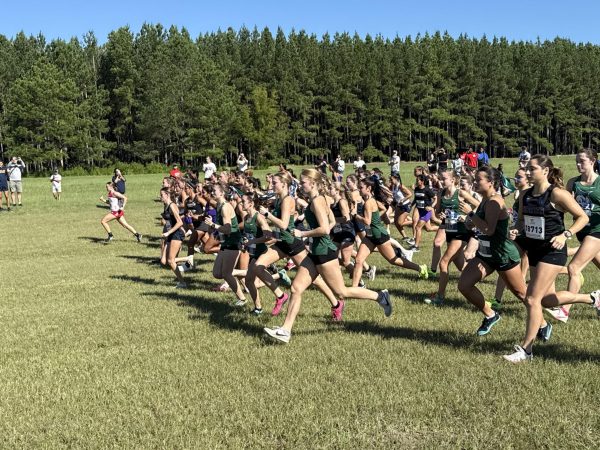
Last Friday evening, the rolling hills of GCSU’s new cross country course bore witness to fierce competition in the Bobcat Invitational. Hosted on the university’s West Campus, the meet featured a women’s 5K race followed by an 8K men’s race, making it a focal point of the Fall season for many teams.
The start and finish lines of this new stage were positioned in great spectator areas, creating a close vantage point for viewers. For many on campus, this was the debut of a course they would come to see again at the upcoming Peach Belt Conference Championship, which the Bobcat course is slated to host.
Students on GCSU’s Cross Country team react to the new course and the challenging uphill battle it presents.
“It’s definitely challenging,” said Emma Jow, a junior english major and Captain of the women’s Cross Country Team. “It’s a little slower than others, but that doesn’t mean that it’s bad. It just means it’s a little more difficult. One of the things that’s tough about discourse compared to others, is there’s lots of different, like ground textures.”
Other students seem to echo Jow’s remarks, displaying an overall sense of comfort and challenge when on the course, whilst sharing discomfort regarding the rugged terrain.
“My coach calls it a true cross country course,” said Daniel Laird, a junior environmental science major, “Just because it’s not like a circle in the middle of a field. It’s like, actually, you’re running over obstacles and like really trying to do more technical stuff while you’re racing. So I like it.”
Organizers had lined the route thoughtfully, weaving through open fields, wooded stretches and tight slopes, a mix intended to challenge runners while also rewarding tactical patience. While many found the course frustrating, others remarked that it presented a fun challenge. Overall, it was a great night for a run.
While the course was challenging, many runners remarked on their true biggest weakness while running, their mental perseverance.
“It’s almost like you’re racing yourself out there sometimes,” Laird said.
Beyond physical preparation, an athlete’s mental state can make or break a race, especially in the unpredictable conditions of cross country.
“I have a hard time separating running from my personal life,” Jow said. “So a lot of times, if I’m under a lot of stress, it will kind of translate into my performance, because I’ll just find it a lot more difficult. And so I’m working on overcoming that just by trying to keep them a little more separate, like leaving school at school and practice at practice, you know?”
For seasoned competitors, staying mentally locked in can be a matter of victory or defeat. The early fall heat, combined with the rough conditions of the track and not to mention midterms, all have impacts on the psychological hurdles that came with Friday’s race.
Athletes mentioned that racing on their home course provided a mental edge; they knew where the tough stretches were and could mentally prepare for them in advance. Conversely, visiting teams had to adapt quickly, which can rattle less experienced runners.
“There’s one really, really long hill,” Jow said. “It’s about 200 meters straight uphill and you do it twice. And so none of the other teams obviously knew that that hill was back there, but we all knew, and we’ve been practicing on it multiple times.”
Other runners remark on this infamous hill and how it presents a mental challenge within the run.
“This hill is actually insane,” said Emily Wright, a senior philosophy and political science major. “I mean, the biggest hill, it’s about a mile in, I want to say. You just keep going up and up, and it’s kind of like a round staircase, so every corner you think you’re done, and then you’re like ‘Oh, this keeps going’ yeah, so I think it ‘s really mentally tough.”
Cross country, perhaps more than many other sports, demands that athletes embrace discomfort rather than avoid it. This is why training can be so rigorous; every strong race is built on weeks, often months of steady, disciplined training. A runner’s performance doesn’t happen overnight; it’s often the result of early morning runs, structured workouts and consistency with intangible skills.
Cross-country training typically combines aerobic base-building, endurance training and strength training to prepare runners for the unique demands of racing over grass, trails and hills.
“Well, for this week, specifically, our coach has been making us run on our course, like doing workouts and stuff all the time,” Laird said. “Just to kind of get us used to like running back there and all the different turns and whatnot. And we’ve been doing a lot more hill work this year as well, to kind of get ready for the back half of our course.”
GCSU’s team entered the meet with several weeks of training and summer conditioning under their belt. Their ability to place multiple runners within the top 20 reflected not just talent, but well-planned training cycles that emphasized both individual and team development.
The Bobcat Invitational was more than just another meet; it was a clear showcase of preparation, mental grit and competitive spirit.

